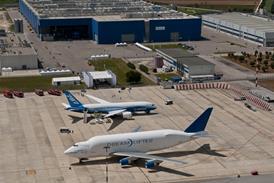As ever, there will be plenty of socialising alongside more sober networking when Europe’s business aviation community gathers for its annual EBACE convention in Geneva from 28-30 May. But amid the back slapping and popping corks, attendees also will be taking stock of mixed market signals as the short-lived Covid upturn in demand continues to lose its fizz.
Will attendees take a glass half-full view of prospects, or see their Champagne flutes as on the way to empty?
From a gloomier perspective, Europe’s business aviation traffic fell by 5.5% in the year to February 2024, based on Eurocontrol data. Numbers flying from the region’s four busiest business aviation airports – Paris Le Bourget, Geneva, Farnborough, and Luton – were also down. Additionally, the sector faces the threat of an angry environmental lobby keen to stage disruptive protests at business airports and events, and to shame firms using private aviation.
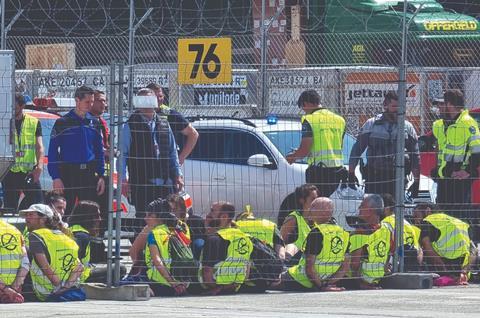
There are, however, some reasons to be cheerful. Business aviation’s popularity in Europe is down on the mid-2020 to mid-2022 period, when frustrated travellers sought private flights while the commercial aviation sector was in chaos with grounded aircraft and services being cancelled at short notice. However, 2023 traffic volumes were still ahead of 2019 and the previous decade average, when the industry was seen to be doing well. So it is far from a crisis.
Moreover, away from Europe, the industry appears in robust health, with global deliveries of new business and general aviation aircraft last year increasing by 3.6% to top more than 4,000 for the first time in more than a decade, according to trade body the General Aviation Manufacturers Association (GAMA). While these figures include everything from small piston-singles, all segments were up, including business jets, where shipments grew by 2.5%.
North America continues to perform strongly, although Europe’s traffic appears to be adjusting back to levels seen through most of the 2010s, suggests Richard Koe, managing director of market intelligence provider WingX. Factors include the collapse of the Russian market after the 2022 Ukraine invasion, and economic malaise in Germany and other big European countries.
“There are a lot of headwinds, including pressures on corporate flight travel generally,” he says.
Also, the return of airline services – albeit with connectivity still less than it was pre-Covid – has affected the once booming leisure market, Koe believes. This spiked for about two years from summer 2020, as wealthy Northern Europeans – unable to book scheduled flights and worried about catching the virus on packed airliners and at busy airports – chartered light jets to escape to Mediterranean boltholes.
GREEN LOBBY
The challenge from the green lobby comes not just from the likes of the activists who broke through the perimeter fence and chained themselves to business jets at the static display at EBACE 2023, or who joined Greta Thunberg in Farnborough earlier this year to protest an application by the owners of the business aviation airport to increase flights from 50,000 to 70,000 per year.
While these groups would gladly outlaw all business aviation movements tomorrow – “The fact that using private jets is both legally and socially allowed today in an escalating climate emergency is completely detached from reality,” Thunberg told reporters – there is also growing opposition to the sector from more mainstream politicians, who view with scepticism industry claims to be working towards a net-zero future.

Last November, the Dutch government reluctantly abandoned a move to cap flights at Amsterdam Schiphol airport to 460,000 per year on noise pollution grounds. It followed opposition from airlines, the European Commission, the US government, and the business aviation lobby. The plan would have severely restricted the ability of business aircraft operators to use one of Europe’s busiest hubs.
In June 2023, EU transport commissioner Adina Valean stated that she had “no intention” to impose restrictions on business aviation after calls from the transport ministers of several member countries, including Austria, Belgium, France, Ireland, and the Netherlands. Valean said her priority was to focus on reducing the carbon footprint of aviation as a whole. However, an incoming commissioner – a reshuffle is likely next year – could take a different stance.
With a spate of upcoming elections to potentially change the political landscape across the region, the future is far from clear. Many centre-left politicians are under pressure to be seen as doing more about climate change, and wealthy private aviation users make for an easy target.
“Efforts at curtailing business and general aviation are mounting, especially in Europe, where sensitivity to factors that accelerate climate change is high,” warns GAMA in its review of 2023.
Business aviation is banking on technology – from sustainable aviation fuel (SAF) to, at some point down the line, disruptive propulsion systems – to help reach its environmental goals. “As civil aviation’s innovation incubator, our entire industry is focused on new aircraft and technologies that will lead the way in safety and sustainability for the entire aviation sector,” says GAMA chief executive Pete Bunce.
INCREASED EFFICIENCY
The European Business Aviation Association – which organises EBACE, along with its US counterpart NBAA – takes a similar view. “Business aviation has always been an early adopter of innovative technologies that improve the efficiency of aviation. Since 2009, the business aviation community has been committed to reducing the environmental impact of its products and operations… [and is] ahead of the curve in mitigating its impact on climate change,” it says.
However, will that revolution come quickly enough to counter rising anti-business aviation sentiment? After all, SAF powers only a tiny fraction of the industry’s flights and – while the arguably more sustainable advanced air mobility (AAM) sector plays a role at EBACE – business aviation, like its commercial cousin, is likely to be wedded to the carbon combustion engine for a long time yet.
Koe suspects that increased scrutiny on companies that benefit from business aviation is already influencing behaviours, particularly in Europe. “While regular users of business aviation will continue to fly when they need to, I can see a switch happening, where we move from in-house flight departments to fractional ownership, aircraft management, and charter. There is a concern about potential damage to aircraft [from climate activists],” he says.
Pressure from environmental campaigners is not the industry’s only headache. The Covid-19 hangover of labour and material shortages is also hampering the development and delivery of new aircraft types.
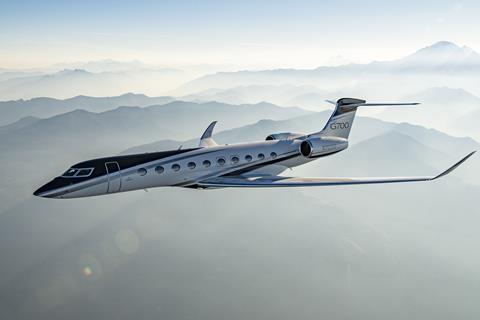
When business aircraft manufacturers struggled to ramp-up production in the wake of the pandemic, demand for and prices of used aircraft soared. During 2022 and 2023, some secondhand types were changing hands for more than the list price of their factory-fresh equivalents.
While that situation has eased, manufacturers are still facing the squeeze. A lack of experienced inspectors at the US Federal Aviation Administration – coupled with an increased scrutiny of Boeing soaking up resources – was partly behind the long delay in the certification process for Gulfstream’s new flagship, the G700. The Rolls-Royce Pearl 700-powered type had originally been slated for delivery in 2022 and was finally certificated in late March.
Dassault Aviation has blamed supply chain disruption, including from European aerostructures firms, for slower-than-expected deliveries of its latest Falcon 6X in 2023 and a delay until 2027 in the arrival of the in-development 10X. In some cases, chief executive Eric Trappier said in March, “missing parts” were holding up the production line. The French airframer shipped just 26 Falcons last year, down six on 2022’s tally of 32 and nine fewer than the 35 units forecast.
BOOSTING PRODUCTION
Rival Bombardier, meanwhile, said in February it expects to boost production of its Global family this year as supply chain pressures ease. The Canadian company also anticipates its newest variant, the ultra-long-range Global 8000, entering service on schedule in 2025. However, chief executive Eric Martel acknowledges that several of its suppliers remain in “catch-up mode” and that its delivery rate will be “largely set by the pace we receive parts from the suppliers”.

After a stream of high-profile aircraft launches in 2021 and 2022 – the Falcon 10X, G800, and the Global 8000 (effectively a relaunch as a reconfigured design) – the sector appears to have entered a more fallow period in product development.
Last year, Textron Aviation announced two new models – the Citation CJ3 Gen2 and the Ascend. However, both are adaptations of existing aircraft, with the Ascend an update of the midsize Excel.
One clean-sheet Textron Aviation product has faced multiple delays that date from well before the pandemic. The company does not now expect first deliveries of the Beechcraft (originally Cessna) Denali single-engined turboprop until 2025: a full 10 years after its unveiling. The company blames slower-than-expected certification of the type’s all-new Catalyst engine, developed by GE Aerospace in Italy and the Czech Republic.
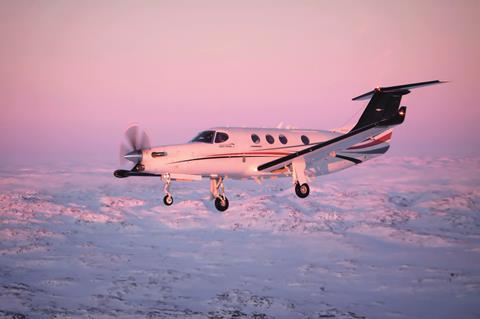
After breaking into the business aviation market in spectacular fashion two decades ago, Embraer has been quiet on the product front since revamping its Legacy 450/500 pairing as the Praetor 500 and 600 almost six years ago, and upgrading its Phenom 100 and 300 light jets.
However, at EBACE last year, Embraer Executive Jets chief executive Michael Amalfitano hinted that a larger business jet might be on the cards at some point.
The Brazilian manufacturer has not played in a segment above super-midsize since ending production of its airliner-derived Legacy 650 and Lineage 1000 four years ago. However, despite its success – the Phenom 300 has been the top-selling light jet for more than a decade – Embraer lacks the deep pockets of its rivals to invest in a new programme following the collapse of plans at the beginning of the pandemic to merge its commercial aviation arm with Boeing.
NEW ECHELON
One airframer developing a new type is Honda Aircraft, which revealed more about its Echelon light jet at last October’s NBAA convention. What is unclear is how much the Echelon will be a derivative of the HA-420 HondaJet light jet, which the company has been delivering for eight years. The two will share a common pilot type rating, although the company suggests that with a range of 2,630nm (4,860km), the Echelon will straddle the light and midsize segments.
There are other differences too, including with key suppliers. Honda Aircraft insists it will be a “clean sheet” model, with, for a start, different engines: Williams International FJ44-4Cs, as opposed to the GE Honda HF120s on the original jet.
Spirit AeroSystems has been enlisted to provide the Echelon’s carbonfibre fuselage – GKN Aerospace makes the basic structure of the HA-420. The airframer is aiming to fly the first example of the new type in 2026, with certification two or three years later.
Honda Aircraft’s competitor in the light-jet category, Pilatus, last year announced a payload and range boost for its PC-24, with deliveries of the new variant starting this year. However, with Pilatus able to sell more of the FJ44-4A-powered type than it produces, another all-new launch from the secretive Swiss manufacturer – which shocked the industry with the unveiling of its first jet at EBACE 11 years ago – looks unlikely for some time.
So, who might be making the news this year at EBACE, the third show since its return after the pandemic? Two of the companies that will not are Bombardier and Gulfstream. These giants of the sector have opted not to participate in the event in 2024, directing their marketing budgets elsewhere.
However, the other big airframers – Dassault, Embraer, and Textron Aviation – are committed to exhibiting at Geneva’s Palexpo.
While the show’s organisers and the Swiss security authorities will be hoping to prevent a repeat of last year’s stunt by protestors, the industry’s attempts to improve its environmental image and performance will be high on the agenda.
A sustainability summit taking place over the show’s three days will cover topics such as SAF, AAM, using operational planning to cut greenhouse gas emissions, and the potential of hydrogen propulsion.
ELECTRIC START-UPS
Several clean-aviation start-ups will again also be represented on the show floor. They include electric vertical take-off and landing aircraft developer Lilium, hybrid-electric fixed-wing pioneer VoltAero, and French market entrant Beyond Aero, which claims to have made that country’s first manned, hydrogen-powered flight.
A Toulouse-based start-up, Beyond Aero flew a modified GI Aviation Spyl-XL ultralight – named Bleriot after the pioneering French aviator – from Gap-Tallard airfield in southeast France during a two-week period from 5 February.
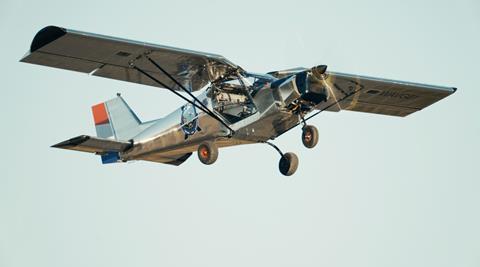
Vaeridion, meanwhile, will be showing its “electric microliner” concept, and US-based Hydroplane its hydrogen fuel cell powerplant technology.
EBACE is an event at which industry professionals can for a few days forget about routine workplace concerns, focus on the future, and have a good time, despite Geneva’s eye-watering prices.
However, with the community facing so many existential challenges – including distant but credible political threats to its very existence – many may be hoping that when the stands get packed away, the party is far from over for business aviation in Europe.




